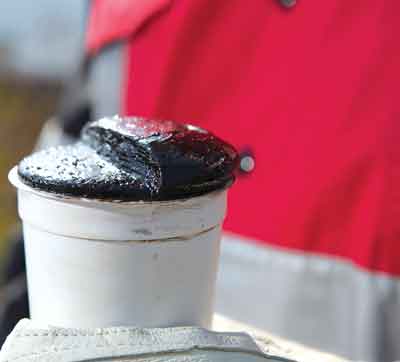Explosives supplier BME recently noted that bulk emulsion explosives have come a long way since the company introduced double-salt [ammonium nitrate/calcium nitrate (AN/CN)] cold emulsion products into South Africa more than 30 years ago.
 BME says it can supply emulsion explosives in customized formulations to suit individual customer needs.
BME says it can supply emulsion explosives in customized formulations to suit individual customer needs.“Factors like safety, stability and performance are still vital for the mining sectors that rely on emulsions for their blasting activities, but the technology is constantly being developed to meet and exceed customers’ expectations,” said BME General Manager–South Africa and Namibia Albie Visser. “Ongoing research and development has put us in a position where we are now able to customize the emulsion to suit the needs of each quarry or mine.”
Emulsions have made blasting safer because they are not classified as an explosive until sensitized in the blasthole; up to that point, their status as a 5.1 oxidizer makes them safe to transport and handle, and simplifies logistics by not requiring the special licensing, permissions and facilities required by traditional explosives.
BME said the long shelf-life of the emulsions makes them easier to store, allowing mines to reduce supply chain risk where distances and accessibility make transportation difficult; and they do not require dedicated magazine facilities, saving on cost and administration.
BME also pointed out that with double-salt formulation, the emulsion has a lower “fudge” point than single-salt emulsions, which means that the temperature required in the manufacturing process can be lower without crystals forming. Fudging results from the formation of unwanted nitrate crystals in the solution phase that thicken and harden the emulsion, making gassing and pumping impossible and the explosives non-detonable.
Many customers have applications in which the emulsion needs to be pumped a number of times before it is fed into blastholes. “This doesn’t pose a challenge for us, as the double-salt formulation allows us to successfully re-pump our emulsion multiple times, with no degrading impact on the product,” said Visser.
Emulsions also have a higher velocity of detonation than ammonium nitrate/fuel oil (ANFO), which improves fragmentation for hard rock mines. In underground applications, it reduces damage to side walls and hanging walls as there is less gas energy and more shock energy in the product.
“With our experience of developing, manufacturing and testing emulsions in the field, our emulsions have evolved to offer value-adding benefits,” said Visser. “In fact, we can now engineer a site-specific emulsion for a customer’s particular conditions and blast outcomes.”
BME has also made progress in helping customers address the challenges created by reactive ground, by developing a specialized emulsion for use in these conditions. Reactive ground is commonly encountered when drilling in shale overburden on coal deposits, in the coal seams themselves and in sulphide orebodies. Under some of these conditions, fine sulphides created by drilling can dissolve in water, which in turn reacts with normal emulsion and potentially degrades blast performance of the blast or worse—a premature reaction of the explosives. BME said its specialized product does not react, ensuring problem-free blasting in reactive ground. CVC to Distribute Uras Vibratory Motor Line in US Uras Techno, one of the world’s largest manufacturers of electric vibratory motors, has appointed Cleveland Vibrator Co. (CVC) as its exclusive distributor of rotary electric vibrators in the U.S., according to Craig Macklin, CVC vice-president of sales and marketing. The Uras line of vibrators was launched in 1959 and more than 830,000 units have been purchased to date.
The full line of Uras KEE and SEE rotary electric vibrators is now marketed under the Cleveland Vibrator private-label RE and RES line in the U.S. The continuous-duty vibrators are used on vibratory equipment such as feeders, conveyors, screeners and tables and are also used as flow aids on bins and hoppers.
Uras rotary electric vibrators feature an antivibration lead cable, fully adjustable force outputs up to 100% rather than limited to set stop points, fully enclosed construction (TENV) and a strong motor shaft with less deflection and continuous duty rating for long service life in harsh conditions. Cleveland Vibrator said it has added more value to the units with Grade 5 mounting fasteners, higher IP ratings and upgraded paint specs.
CVC now offers more than 50 models in the RE and RES line of rotary electric vibrators available in single or three-phase AC power for 110V, 230/460V, 380V and CSA approved 575V. Depending upon the model, force outputs range from 30 lb to more than 46,000 lb. Included in this line are 2-pole (3600 RPM), 4-pole (1800 RPM), 6-pole (1200 RPM) and 8-pole (900 RPM) configurations.









